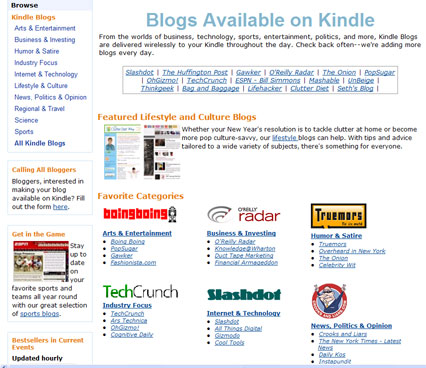Amazon.com starts shipping its highly anticipated Kindle 2.0 e-book reader tomorrow. The device is a significant enhancement over the 1.0 version with a much slimmer form factor; additional storage space and expanded wireless coverage. Kindle owners cannot only read books, but also magazines, newspapers and most interestingly – blogs. When I discovered this fact, my first reaction was to go to Amazon’s web site to determine how to make my blogs available for download on Kindle. Much like I had added a podcast series to Apple’s iTunes store, I was hoping to add a blog feed to Amazon’s Kindle store. The instructions from Amazon are available at online.
I was surprised to discover a number of unexpected aspects of Amazon’s approach:
- Charging for Blogs – Amazon is assessing a monthly subscription fee for each blog you subscribe to. Some blog feeds such as Amazon’s were free, while others were charging $0.99 or $1.99. Royalties are paid back to the author after subtracting a revenue share for Amazon.
- Registration Complexity – Bloggers have to complete a W-9 form with their US Tax Identification Number and Federal Business Classification Profile in order to set up their content for distribution via Kindle.
- Application Backlog – I was least surprised to learn that there is a substantial queue of applicants seeking to feed their blogs to Kindle. The Amazon site states “Due to overwhelming interest in the program, we currently have a content backlog. We ask for your patience as we work through this queue.”

Amazon Kindle Blog Home Page
The application backlog is to be expected given the popularity of Amazon’s new device. But I am thoroughly perplexed by the idea of charging for blog content on the device. The blogs available on Kindle include popular content such as Seth Godin, ESPN’s Bill Simmons and the New York Times Freakonomics. Of course, posts to these blogs can be read from any other Internet enabled device such as an Apple iPhone, PC or Mac for free. Furthermore, Kindle has only limited Internet Browser support in its 2.0 version. As a result any links referenced in the blogs or other interactive content would likely be rendered useless on the device. I suppose if you are an avid reader and only want to have one mobile device, then the idea of paying for blog content could be worthwhile. However, most people in the market to purchase a $400 e-book reader probably already carry a higher-end mobile device such as a Blackberry or an Apple iPhone, with a fully functional browser and RSS reader. This begs an interesting question of how RIM, Apple and Amazon will compete in the world of mobile devices. More in a future post…









